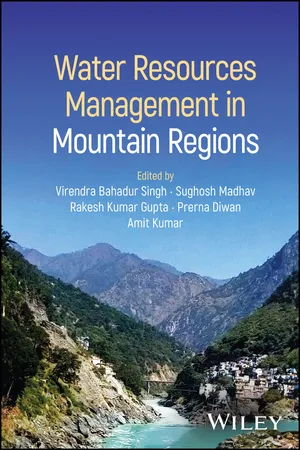
Water Resources Management in Mountain Regions
- 448 pages
- English
- PDF
- Available on iOS & Android
Water Resources Management in Mountain Regions
About this book
An up-to-date and comprehensive analysis of mountainous region water resource management
In Water Resources Management in Mountain Regions, a team of distinguished researchers delivers an up-to-date survey of mountain region hydrology, including the assessment, dynamics, and modeling of glaciers, rivers, and lakes, as well as coverage of the impact of climate change and anthropogenic activities on mountain ecosystems. The authors discuss the challenges posed for those attempting to sustainably manage water resources and explain the impacts of those challenges on water yield, water quality, and the risk of flash flooding.
The book includes several case studies from the Himalayan mountain range, which serves as a model region for both medium-high and very high-altitude water resources. It also examines traditional methods of water resource management and conservation and their relevance for 21 st century strategies.
Readers will also find:
- A thorough introduction to the management challenges of water resources in the Sikkim Mountain regions
- Comprehensive explorations of the microbial dynamics, ecological resilience, and sustainable management strategies of mountainous water resources
- Practical discussions of the application of Geographic Information Systems and Remote Sensing in Satpuda mountainous terrain
- Complete examinations of water resource vulnerability to climate change in the mountain regions of India
Perfect for scientists and other professionals working in surface and subsurface hydrology, environmental management, and climate science, Water Resources Management in Mountain Regions will also prove invaluable to professionals working in companies and governmental institutions involved in water resource exploitation and conservation, hydroelectric power generation, and disaster prevention.
Frequently asked questions
- Essential is ideal for learners and professionals who enjoy exploring a wide range of subjects. Access the Essential Library with 800,000+ trusted titles and best-sellers across business, personal growth, and the humanities. Includes unlimited reading time and Standard Read Aloud voice.
- Complete: Perfect for advanced learners and researchers needing full, unrestricted access. Unlock 1.4M+ books across hundreds of subjects, including academic and specialized titles. The Complete Plan also includes advanced features like Premium Read Aloud and Research Assistant.
Please note we cannot support devices running on iOS 13 and Android 7 or earlier. Learn more about using the app.
Information
Table of contents
- Cover
- Title Page
- Copyright Page
- Dedication Page
- Contents
- About the Editors
- List of Contributors
- Preface
- Chapter 1 Management Challenges of Water Resources in Sikkim Mountain Regions
- Chapter 2 Basin-Scale Estimation of Runoff Components Using the SPHY Model: A Case Study of the Koshi River Basin, Central Himalaya
- Chapter 3 Assessment and Prediction of Water Yield in the Chandra Basin, Western Himalaya, India: : Using Physical Basis SWAT Model and Machine Learning
- Chapter 4 Assessment of Suspended Sediment Properties and Particle Load for Optimal Operation of Hydropower Plants in the Himalayan Region
- Chapter 5 Hydrochemistry and Quality Assessment of High-Altitudinal Kareri Lake, Northwest Himalaya, Himachal Pradesh, India
- Chapter 6 Water Quality Assessment of Lakes in Mountain Region with Spatial Reference to Amarkantak, Madhya Pradesh, India
- Chapter 7 Hydrogeochemical Evaluation of Groundwater Quality in Leh Town, Trans-Himalaya, India Using Entropy Water Quality Index
- Chapter 8 Revival of Drying Springs in Mountainous Regions of the Himalayas – Inferences from an Isotope Hydrochemical Study
- Chapter 9 Biogeochemical Characterization of Water Resources in the Indian Himalayan Regions
- Chapter 10 Mountainous Water Resources: Understanding Microbial Dynamics, Ecological Resilience, and Sustainable Management Strategies amidst Climatic Challenges
- Chapter 11 Modeling the Glacier Energy and Mass Budget of the Phuche Glacier in the Cold-arid Trans-Himalayan Region, Ladakh Range
- Chapter 12 Estimation of Ice Thickness and Glacier-Stored Water of the Teesta Basin, Eastern Himalayas, Sikkim, India
- Chapter 13 Snowmelt Runoff Estimation Using Landsat 8 Snow Cover Area Products in Beas River Basin, Western Himalayan via SRM Degree-Day Modeling Approach
- Chapter 14 Management of Water Resources Through the Application of Geographic Information Systems and Remote Sensing for Satpuda Mountainous Terrain, Madhya Pradesh, India
- Chapter 15 Assessment and Management of Flash Floods in the India Himalayas: Challenges, Strategies, and Solutions
- Chapter 16 Critical Perspectives on Climate Change and Glacial Lake Outburst Floods’ Impact in the Himalayas: Policy Inferences from the South Lhonak Flood of 2023
- Chapter 17 A Comprehensive Review on Water Resource Vulnerability to Climate Change in the Mountain Region of India
- Chapter 18 Rainfall Intensity and Return Periods of Extreme Rainfall Over the Garhwal Himalaya, Uttarakhand, India
- Chapter 19 Traditional Techniques of Rainwater Management and Conservation in the Mountainous Regions of North-East India
- Chapter 20 Sustainable Management of Groundwater Along the Foothills Focusing on Mountain Front Recharge: A Global Review and Status with Regard to Indian Context
- Index
- EULA